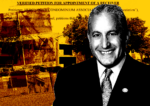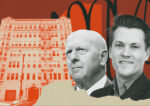Trending
 “Multifamily is in the crosshairs”: Execs talk distress, opportunities at Milken conference
“Multifamily is in the crosshairs”: Execs talk distress, opportunities at Milken conference "Financially devastating": Receiver takes over embattled Pembroke Pines condo complex
"Financially devastating": Receiver takes over embattled Pembroke Pines condo complex Goldman Sachs and Ballast ready to surrender SF apartments to lender
Goldman Sachs and Ballast ready to surrender SF apartments to lender Pinnacle Bank buys back Fort Worth office tower for $12 per sf
Pinnacle Bank buys back Fort Worth office tower for $12 per sf NYU expansion detractors rally at public hearing
Sen. Tom Duane, university faculty among protestors of 20-year-long project while Columbia president came in support

Protesters were out in force this morning at the City Planning Commission’s sole public hearing on New York University’s proposed Greenwich Village expansion plan at the Financial District’s Museum of the American Indian. With posters and signage in tow, the project’s detractors seemed to far outweigh its supporters at the hearing, still ongoing, which marked the first stage of the mandatory review and approval process for the NYU plan. More than 200 people signed up to voice their views on the project, which includes the development of four new buildings on the blocks bounded by Laguardia Place and Mercer Street, and West Houston and West 3rd streets.
Recent concessions by NYU — including the reduction in total size of the buildings by 370,000 square feet to slightly more than 1.9 million square feet — did not seem to have pacified protestors, who called the changes “modest.”
“Our single overriding concern with the NYU plan is that it allows the university to increasingly dominate our neighborhood,” said Andrew Berman, executive director of the Greenwich Village Historic Preservation Society, a vocal opponent of the project since its inception. “As has happened over the last several decades, more and more of the Village and surrounding neighborhoods will feel populated, controlled, and overwhelmed by a single institution. To approve this plan and allow NYU to take over more of the neighborhood is to doom the village to become akin to a company town.”
NYU is seeking to undo existing zoning provisions, reduce public green space, and remove urban renewal deed restrictions in order to allow it to expand further in the future, the protestors argued, to the blocks south of Washington Square.
“This proposal only satisfies NYU’s stated growth needs for 19 years,” Berman added, eliciting nods from the planning commission panel, headed by City Planning Commissioner Amanda Burden. “What happens in 2031? Approve this plan, and NYU will be back to ask to take more open space, tear down more low-rise buildings, violate more zoning and urban renewal agreements, and further over-saturate this neighborhood.”
Also among the project’s critics were various academics and teachers from NYU as well as New York State Sen. Tom Duane, who said he had “deep concerns” about the university’s expansion.
Dennis Geronimus, associate professor of art history at the college, submitted a statement of opposition to the development plan on behalf of his department, saying: “We are gravely concerned [about] the disruption in this area. Nineteen years of construction will have serious adverse effects not only on the health and quality of life of our present faculty but also on the recruitment of outstanding new faculty.”
The professor was also eager to emphasize that the views of the NYU administrators that came out in support of the project, including Lynne Brown, senior vice president for university relations, and university President John Sexton, did not represent the university faculty as a whole.
“They do not speak for the two-thirds of all NYU faculty who voted against [the plan] in this month’s NYU Faculty Senate Council online study,” he said. “Our opposition is resolute, founded on well-grounded facts and concerns – and is only growing with each passing week as more and more faculty, even those still untenured who feel a degree of fear in speaking out, learn about the consequences of the $4 [billion] to $6 billion, two-decade-long plan.”
Meanwhile, Sexton argued that the expansion project is at the “essence of the success of the university,” and is required in order to sustain the academic momentum of the institution. Using Tisch School of the Arts as an example, he said that the college is currently compressed and in desperate need of more space. Tisch is still occupying a building designed for one-quarter of the student population it now houses, he said.
Columbia University President Lee Bollinger, who turned out in support of the proposal, agreed: “Universities are essential of the creative spirit of New York,” he said, referencing the expansion of Columbia University into Manhattanville. “A rich urban environment of colleges works to the benefit of all of us.”
The presentations from project supporters drew many questions from members of the planning commission, who wished NYU to quantify why some of the expansion could not take place outside of Greenwich Village, an argument also touted by the protestors. They asked the proponents to submit more paperwork to outline their reasoning behind which elements of the expansion needed to happen in Greenwich Village. They did not give a deadline for the submission.
NYU has made steps to expand in the other boroughs, however. Earlier this week, the city and the university reached a deal to turn 370 Jay Street, an office building in Downtown Brooklyn, at MetroTech Roadway, into the Center for Urban Science and Progress. Marking the next step in the city’s Applied Sciences NYC initiative, NYU will repurpose the 460,000-square-foot tower that served as the headquarters of the state-run Metropolitan Transportation Authority for 30 years, The Real Deal previously reported.
A final decision from city planning on the rezoning is expected June 6, according to an agency spokesperson. The expansion also requires City Council approval.
